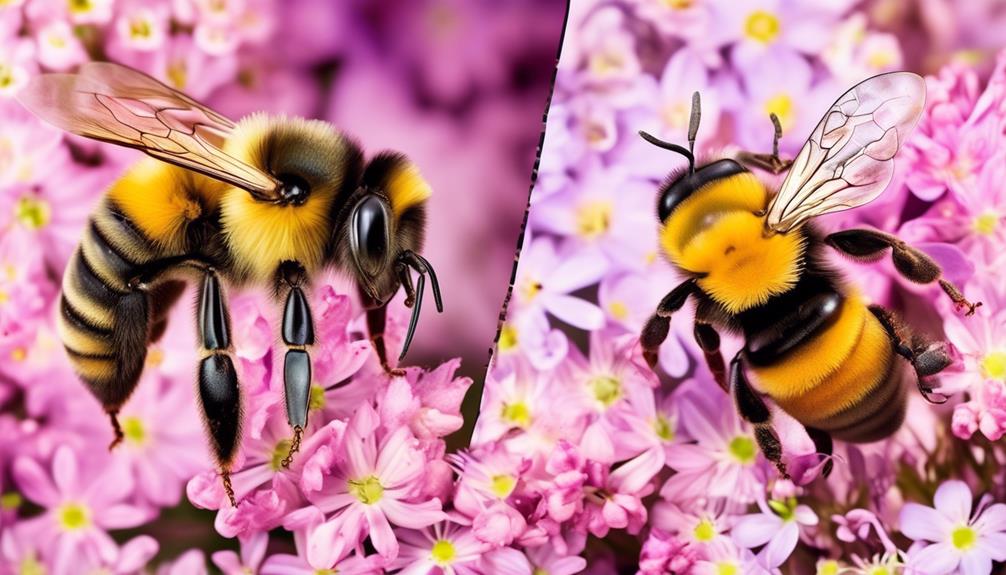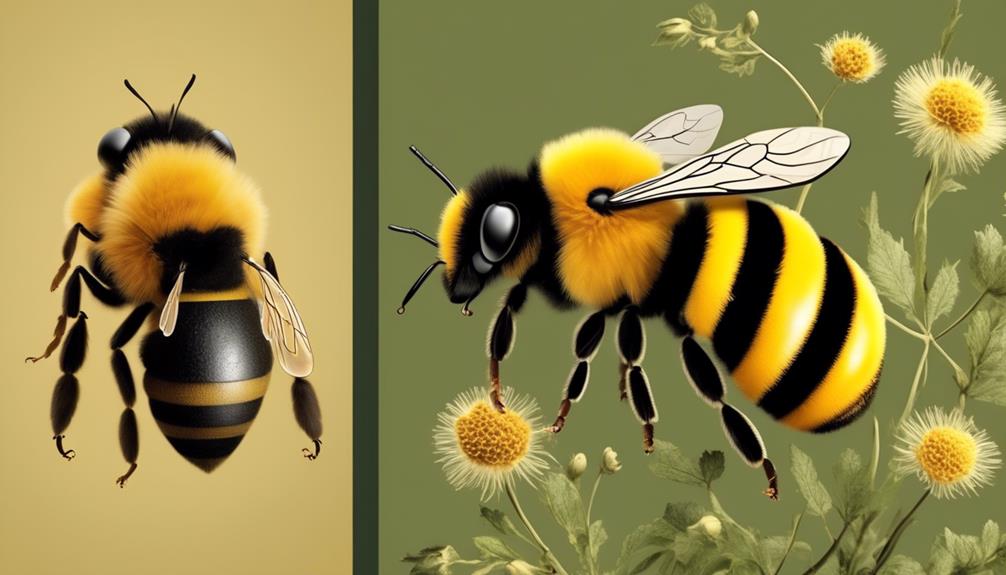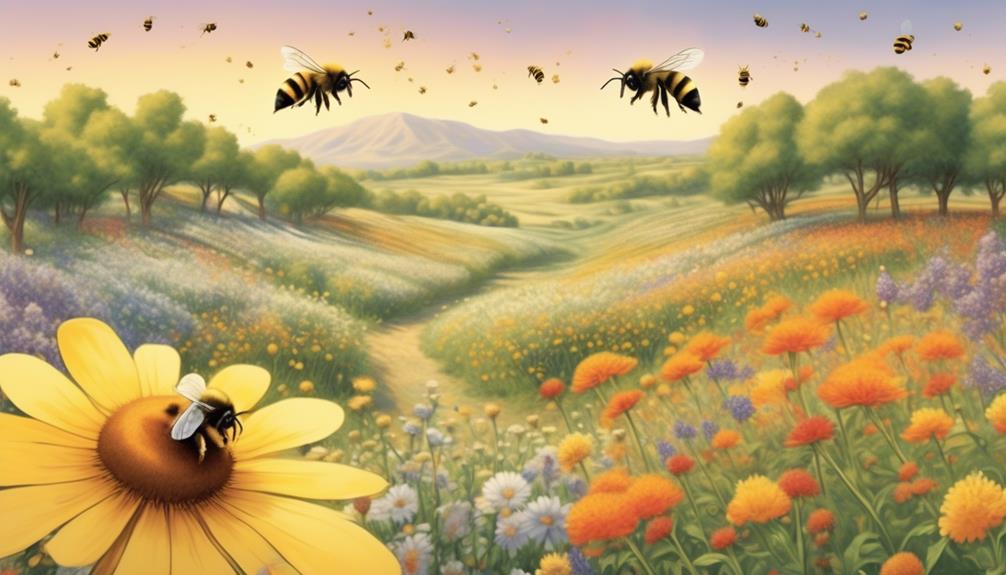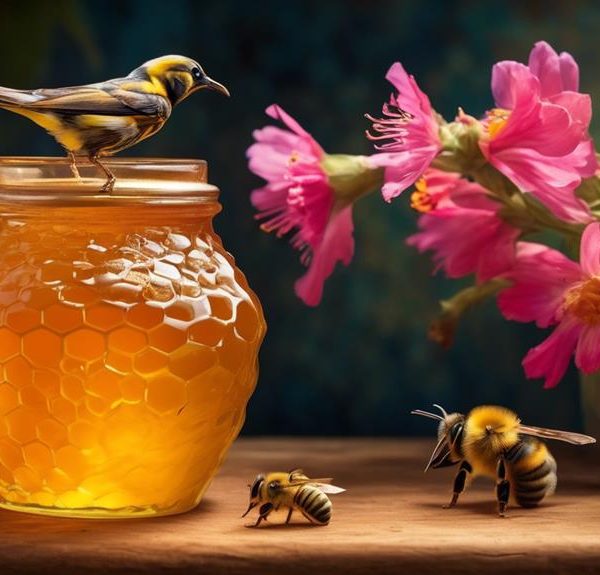Journey into the fascinating world of bees and discover the surprising differences between bumble bees and honey bees.

Are Bumble Bees and Honey Bees Different
Just by chance, you might have wondered whether bumble bees and honey bees are the same or if there's more to these buzzing creatures than meets the eye. You're not alone in this curiosity and it's high time we explored it.
Interestingly, while they share the bee label, they're as different as chalk and cheese in many aspects. From their physical attributes to their social structures, their roles in pollination, and even their conservation struggles — these differences are fascinating and far-reaching.
Stick around and you'll discover why these distinctions matter more than you might think.
Key Takeaways
- Bumble bees and honey bees have distinct physical differences in size, body shape, and coloration.
- The social structures of honey bees and bumble bees differ significantly, with honey bees having a more complex society.
- Both honey bees and bumble bees play critical roles in pollination, but their foraging behaviors and preferences vary.
- Bees face various threats to their survival, including habitat loss, pesticides, climate change, and diseases, emphasizing the importance of conservation efforts.
Understanding Bee Basics

Before diving into the disparities between bumble bees and honey bees, it's crucial to grasp some basic bee biology that'll serve as your foundation. Bees belong to the insect order Hymenoptera, sharing the same lineage with ants and wasps. They're recognized for their role in pollination, vital to the ecosystem and our food supply.
In terms of anatomy, bees possess two pairs of wings and six legs. They've got a hard exoskeleton, a three-part body (head, thorax, abdomen), antennae for sensing their environment, and, in some species, a stinger for defense. You'll find a range of sizes and colors among bees, but they commonly exhibit black and yellow markings.
The bee lifecycle is a dramatic transformation process, known as metamorphosis, that unfolds in four stages: egg, larva, pupa, and adult. The queen bee lays eggs that hatch into larvae, then transform into pupae before emerging as adult bees.
Understanding these fundamentals, you're now equipped to delve deeper into the fascinating world of bees. Next up, we'll explore the distinct traits and behaviors that set bumble bees and honey bees apart.
Physical Differences: Bumble Bees Vs Honey Bees

Let's start by examining the physical characteristics that distinguish the robust, fuzzy bumble bee from the more slender, less hairy honey bee. You'll notice that bumble bees have a rounder, furrier appearance with a broad, striped abdomen. They are larger, measuring up to 1 inch in length. Their hairy bodies, often black and yellow, are designed to collect pollen.
On the other hand, honey bees are smaller, typically about half an inch long. They possess a slender, more streamlined body shape with fewer hairs. Their abdomen is more elongated, with a pattern of amber and brownish-black stripes.
For a clearer comparison, refer to the table below:
Bumble Bees | Honey Bees | |
|---|---|---|
Size | Up to 1 inch | About 1/2 inch |
Body Shape | Round, fuzzy | Slender, less hairy |
Color Pattern | Black and yellow stripes | Amber and brownish-black stripes |
Both bees play critical roles in our ecosystem, and understanding their physical differences can help you identify them correctly. Remember, their appearances aren't just for show – each characteristic has a specific function that aids their survival and propagation.
Social Structure and Behavior Variations

Diving into their social structures and behavioral patterns, you'll find that bumble bees and honey bees exhibit stark differences which are as fascinating as they're crucial to their survival. Honey bees operate within a complex, highly organized society, with a singular queen bee, numerous worker bees, and a smaller contingent of drones. Each caste fulfills distinct roles, from reproduction to foraging to hive maintenance.
In stark contrast, you'll observe that bumble bees function within a simpler, less rigid social structure. Their colonies are smaller, often comprising of just a few dozen bees, and while they too have a queen and worker bees, their roles aren't as strictly defined.
Behaviorally, honey bees are known for their intricate 'waggle dance,' an advanced communication method they use to convey the location of food sources. Bumble bees, on the other hand, don't perform this dance. Instead, they rely on individual exploration and random search patterns to gather food.
These variations highlight the remarkable adaptability of these insects, each exhibiting strategies that have enabled their respective species to thrive in diverse environments.
Role in Pollination and Ecosystem

Having explored the social and behavioral differences between honey bees and bumble bees, we now turn our attention to their vital roles in pollination and the broader ecosystem.
Both species play crucial roles in the pollination process, which in turn maintains biodiversity and supports crop production. But there are differences in how they contribute.
Honey Bees | Bumble Bees | |
|---|---|---|
Pollination | Honey bees are meticulous and systematic, visiting flowers of a single species in one outing, which aids in cross-pollination. | Bumble bees are less selective, visiting a variety of flowers, which promotes greater genetic diversity. |
Contribution to Ecosystem | Honey bees, being more populous, have a wider impact on crop pollination. | Bumble bees, with their larger bodies and ability to 'buzz pollinate', are critical for certain plants like tomatoes and blueberries. |
Vulnerability | Honey bees are more susceptible to pesticides and diseases, which can impact crop yields. | Bumble bees are more resistant to these threats but are more affected by climate change. |
In essence, while they each have their unique strengths and vulnerabilities, both honey bees and bumble bees are vitally important in maintaining the health of our ecosystems.
Threats and Conservation Efforts

Despite their crucial role in our ecosystems, both honey bees and bumble bees are facing a myriad of threats that could potentially jeopardize their survival and, consequently, our own food security. Habitat loss, pesticide exposure, climate change, and diseases all pose significant challenges to these vital pollinators.
Take habitat loss, for instance. Urbanization and intensive farming are eroding their natural habitats, leaving them with fewer places to nest and forage. Pesticides, particularly neonicotinoids, can impair their foraging skills and decrease their resistance to diseases, which are increasingly prevalent due to global trade and climate change.
These threats aren't just problematic for the bees; they're a problem for us too. As the primary pollinators of many of our crops, their decline could seriously disrupt our food supply. That's why conservation efforts are so critical. From creating pollinator-friendly gardens to reducing pesticide use, we can all play a part in safeguarding their future. Major initiatives, such as the Pollinator Health Task Force in the U.S. and the EU's ban on neonicotinoids, also provide hope for these indispensable creatures.
Conclusion
In conclusion, you've seen that bumble bees and honey bees aren't just different in appearance, but also in social structure, behavior, and their roles in pollination.
It's crucial to understand these differences, as each species faces unique threats and requires specific conservation efforts.
Their survival isn't just about preserving biodiversity; it's about safeguarding our ecosystem.
Continuing to explore and respect these differences is key to ensuring their—and our—future.



